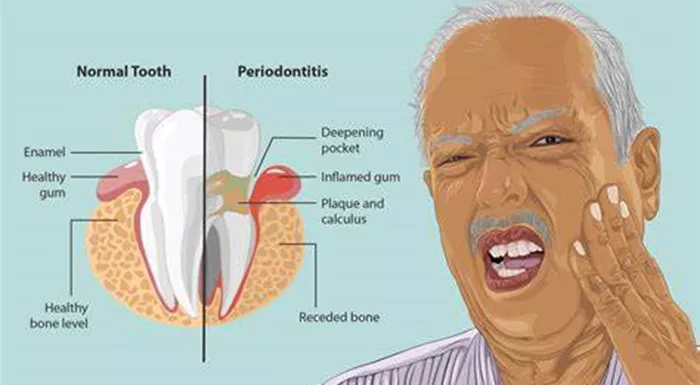Periodontal disease, also known as gum disease, is a chronic inflammatory condition affecting the gums and the structures supporting the teeth. It ranges from mild gingivitis to severe periodontitis. While the early stages of gum disease can be relatively easy to treat and reverse, advanced periodontal disease presents a more significant challenge. This article explores whether advanced periodontal disease can be reversed, examining the stages of the disease, treatment options, and preventive measures.
What Is Periodontal Disease?
Periodontal disease begins with the accumulation of plaque, a sticky film of bacteria that forms on teeth. If not removed through regular brushing and flossing, plaque hardens into tartar (calculus), which can only be removed by a dental professional. The presence of plaque and tartar leads to inflammation of the gums, known as gingivitis. Symptoms of gingivitis include red, swollen gums that may bleed during brushing or flossing. At this stage, the condition is still reversible with proper oral hygiene and professional dental care.
When gingivitis is left untreated, it can progress to periodontitis, a more severe form of periodontal disease. In periodontitis, the inflammation extends deeper into the supporting structures of the teeth, including the bone. This can result in the formation of pockets between the teeth and gums, which become infected. The body’s immune response to the infection can lead to the destruction of bone and connective tissue, ultimately causing tooth loss if not managed properly.
SEE ALSO: Does Removing Teeth Cure Periodontal Disease
Can Advanced Periodontal Disease Be Reversed?
Advanced Periodontal Disease: A Challenging Stage
Advanced periodontal disease, or severe periodontitis, is characterized by deep pockets of infection, significant bone loss, and loosening of the teeth. At this stage, reversing the condition becomes exceedingly difficult. Unlike gingivitis, where the damage is limited to the gums, advanced periodontitis involves irreversible damage to the bone and connective tissues that support the teeth.
Treatment Goals: Managing the Disease
The primary goal of treating advanced periodontal disease is to manage the condition and prevent further progression.
While complete reversal of the damage may not be possible, appropriate treatment can help stabilize the disease, reduce inflammation, and preserve the remaining bone and gum tissue. Key treatment approaches include:
Non-Surgical Treatments
Scaling and Root Planing: This deep-cleaning procedure involves removing plaque and tartar from below the gum line and smoothing the tooth root surfaces to prevent bacteria from reattaching.
Antibiotics: Systemic or locally applied antibiotics may be used to control bacterial infection in the gum pockets.
Surgical Treatments
Flap Surgery (Pocket Reduction Surgery): The gums are lifted back to remove tartar and smooth damaged bone, reducing the size of the pockets.
Bone Grafts: Bone grafts involve placing natural or synthetic bone in areas of bone loss to promote bone regeneration.
Guided Tissue Regeneration: This procedure uses a special membrane to encourage bone and gum tissue to regenerate.
Soft Tissue Grafts: Soft tissue grafts involve taking tissue from another part of the mouth to cover exposed roots and reinforce thin gums.
Laser Therapy
Laser-Assisted New Attachment Procedure (LANAP): This minimally invasive treatment uses a laser to remove diseased tissue and promote the reattachment of healthy gum tissue to the teeth.
The Role of Maintenance And Prevention
Maintenance Therapy
After active treatment, maintenance therapy is crucial to prevent the recurrence of periodontal disease. This typically involves regular dental check-ups and cleanings, often every three months, to monitor the condition and maintain oral health. Maintenance therapy includes:
Professional Cleanings: Regular removal of plaque and tartar by a dental professional to keep the gums healthy.
Monitoring Pocket Depths: Measuring the depth of gum pockets to detect any signs of disease progression.
Ongoing Patient Education: Reinforcing proper oral hygiene techniques and lifestyle changes to support gum health.
Preventive Measures
Preventing periodontal disease from progressing to an advanced stage is essential. Key preventive measures include:
Daily Oral Hygiene: Brushing twice a day with fluoride toothpaste and flossing daily to remove plaque and prevent tartar buildup.
Regular Dental Visits: Scheduling routine dental check-ups and cleanings at least twice a year to catch early signs of gum disease.
Healthy Lifestyle Choices: Avoiding smoking and maintaining a balanced diet to support overall oral health.
Managing Systemic Health: Controlling conditions such as diabetes that can increase the risk of periodontal disease.
Innovative Treatments And Research
Emerging Therapies
Research into new treatments for periodontal disease is ongoing, with promising developments that may enhance the ability to manage and potentially reverse the condition. Some emerging therapies include:
Host Modulation Therapy: This approach aims to modify the body’s immune response to reduce inflammation and tissue destruction.
Stem Cell Therapy: Investigating the use of stem cells to regenerate bone and gum tissue lost due to periodontitis.
Antimicrobial Photodynamic Therapy: Combining light and a photosensitizing agent to target and destroy bacteria in the gum pockets.
Genetic Research
Genetic research is uncovering the role of genetic factors in periodontal disease susceptibility. Understanding genetic predispositions can help tailor prevention and treatment strategies to individual patients.
The Importance of Early Intervention
Early Diagnosis
The earlier periodontal disease is diagnosed and treated, the better the chances of preventing severe complications. Regular dental visits allow for early detection of gingivitis and early-stage periodontitis, which are more manageable and reversible compared to advanced periodontitis.
Patient Awareness
Educating patients about the signs and symptoms of periodontal disease is crucial. Awareness of the importance of gum health and the potential consequences of neglecting oral hygiene can motivate individuals to seek timely dental care.
Conclusion
Advanced periodontal disease poses significant challenges in terms of reversibility. While it may not be possible to completely reverse the damage once the disease has reached an advanced stage, effective treatment and maintenance can manage the condition and prevent further progression. By combining professional dental care, innovative therapies, and diligent oral hygiene practices, individuals can maintain their oral health and improve their quality of life. Early intervention and preventive measures remain key in the fight against periodontal disease, underscoring the importance of regular dental visits and patient education.

